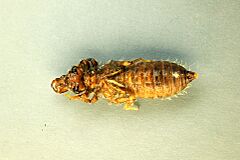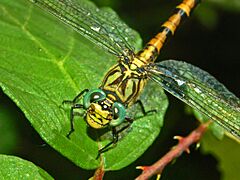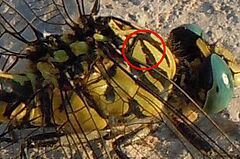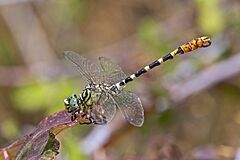Small pincertail facts for kids
Quick facts for kids Small pincertail |
|
|---|---|
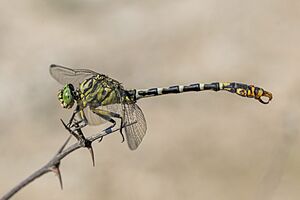 |
|
| Male, Bulgaria | |
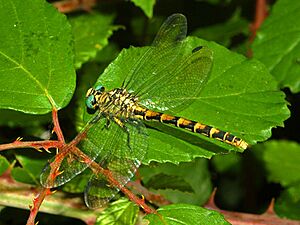 |
|
| Onychogomphus forcipatus var. unguiculatus, female | |
| Conservation status | |
| Scientific classification | |
| Synonyms | |
|
The Small Pincertail (Onychogomphus forcipatus) is a cool type of dragonfly. It's also known as the green-eyed hooktail because of its awesome green eyes and special tail parts. This dragonfly belongs to a family called Gomphidae.
Contents
Different Kinds of Small Pincertails
Did you know there are a few different kinds, or subspecies, of the Small Pincertail? They are all slightly different versions of the same amazing dragonfly. These include:
- Onychogomphus forcipatus var. albotibialis
- Onychogomphus forcipatus var. forcipatus
- Onychogomphus forcipatus var. unguiculatus
Where Do Small Pincertails Live?
This dragonfly is quite common and can be found in many places. You can spot them across most of Europe. They also live in North Africa, in countries like Algeria, Morocco, and Tunisia. Further east, they are found in parts of West and Central Asia, including Armenia, Azerbaijan, Iran, Kazakhstan, and Turkmenistan.
Small Pincertail Homes: Their Habitat
Small Pincertails usually like to live near clean rivers. These rivers often have water that flows a bit fast. They also prefer rivers with gravel or sandy banks. Sometimes, you might even find them near large lakes. They need these specific places to live and lay their eggs.
What Does a Small Pincertail Look Like?
Adult Small Pincertails can grow up to about 6 centimetres (2.4 in) long. Their wingspan (how wide they are with their wings spread) can be between 5.5–7.5 centimetres (2.2–3.0 in). These dragonflies have eyes that are set far apart, and they are usually grey or green. This is why they are sometimes called "green-eyed hooktails"!
Special Markings
If you look closely at their body, you'll see two thin black lines on the side of their chest area, called the thorax. These lines are quite narrow and touch in the middle. They also have a yellow line on the top of their head, which is called the vertex.
Male Dragonflies' Tails
Male Small Pincertails have three large, hook-like parts on their tail end. These are called anal appendages. These hooks can be dark and might have a small tooth near the end. The base of the back wing in males is angled, while in females, it is more rounded.
Spotting the Difference
This dragonfly looks a lot like another species called Onychogomphus uncatus. To tell them apart, you need to look at the shape and size of their black markings. These markings are especially helpful on their chest (thorax) and the last parts of their tail (abdomen).
Life Cycle of the Small Pincertail
You can usually see adult Small Pincertails flying near rivers and lakes from June through September. In warmer parts of Southern Europe, they might start appearing as early as April. In Cyprus, a special type of this dragonfly, O. f. albotibialis, flies from late March all the way to October. This specific type is considered a Near-threatened species, meaning it needs a bit of protection.
From Egg to Adult
After mating, the female dragonfly lays about 500 eggs into the water. The baby dragonflies, called larvae, then dig into the bottom of the river or lake. They live buried there for a long time. Their whole life cycle, from being an egg to becoming a full-grown adult dragonfly, takes about 3 to 5 years!
Gallery
-
Male O. f. albotibialis, Cyprus



